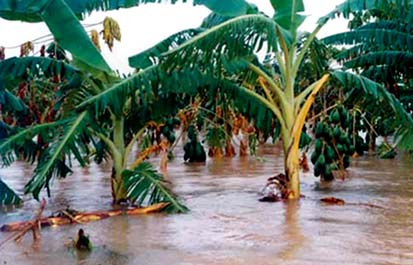To date, watershed management has generally achieved only partial success, largely due to the fact that biophysical factors have been emphasised at the expense of socio-economic concerns and the fact that hydrologic boundaries are not congruent with political boundaries. To be seen as responding to flooding problems, government officials and development agencies regularly launch new watershed-management programmes and projects. The activities under these initiatives typically focus on maintaining or expanding forest cover and encouraging soil and water conservation practices in agricultural areas. Attention is also usually given to curtailing shifting cultivation and stabilising rural settlements. However, sporadic short-term efforts in soil and water conservation and reforestation on individual plots (selected on the basis of farmers’ willingness to participate or direct payments for co-operation) are unlikely to have a discernible flood mitigation effect, even at the level of a small watershed.
Although these types of projects can be beneficial on a local scale, they are not likely to contribute significantly to flood mitigation as a whole. They may, however, contribute to reducing sedimentation, which has adverse effects on aquatic life, reservoir life, potable water quality, irrigation quality and navigation (Hamilton and Pearce 1986).
Watershed management that is heavily reliant on improved farming technologies often ignores the many water resource-related problems that are caused by non-agricultural land uses. Mining and physical infrastructure such as roads, for example, can affect local hydrology far more than agricultural practices, and can lead to uncontrolled runoff and sedimentation of rivers. Effective watershed management identifies the main problem areas or ‘hot spots’ of risk and sets appropriate priorities for mitigative interventions. Under this approach, there is no pre-determined assumption that agriculture and farmers (or forestry and loggers) are the major sources of problems.
Effective watershed management is an iterative process of evaluating, planning, restoring and organising land and resource use within a watershed to provide desired goods and services while maintaining and supporting the livelihoods of resident populations. This process provides an opportunity for stakeholders to balance diverse goals and resource uses, and to consider how their cumulative actions may affect long-term sustainability of natural resources. Embedded in the concept of watershed management is the recognition of the interrelationships of many different activities such as fisheries, urban development, agriculture, mining, forestry, recreation, conservation and other human influences, as well as the linkages between upstream and downstream areas.
An important aspect of watershed management is land-use classification and land-use planning. It is vital that the fragile areas be identified and protected from inappropriate use, whether forestry, agriculture or mining. However, even the ‘best’ plan will have no impact if its implementation is not facilitated by supportive policies, a regulatory framework providing guidance, and incentive systems stimulating behaviour that benefits the watershed and society at large.
|
What can be expected from forest and soil conservation? Forestation of mountain watersheds and extensive soil conservation measures are valuable for the sake of the hill farmers, if appropriately carried out. It is potentially disastrous, however, for foreign aid agencies and national government authorities to undertake such activities with the conviction that they will solve problems in the plains. From: Lauterburg 1993 |
Although watershed classification, planning and management are usually the domain of foresters (or soil conservationists), the profession falls short in recognising that forest management itself - if not practised appropriately - can produce substantial on- and offsite costs. Poor logging practices generate massive quantities of sediments and can substantially influence local stream-flow patterns, especially through increased runoff from landings, skidtrails and logging roads. Thus, effective watershed management also means introducing reduced impact logging, enforcing logging guidelines and adhering to codes of practice for forest harvesting. In addition, riparian forests should be managed rigorously to protect water quality. This is an area where unambiguous research results point to significant environmental benefits.
Unfortunately, the benefits of these techniques are not fully recognised and related practices are not utilised to their full potential. Many logging companies still consider reduced impact logging merely in terms of increased operating costs with no additional economic gains. In the absence of rigorous regulation and targeted incentives, such attitudes typically result in limited application of improved logging practices.
Effective watershed and forest management consistently yield significant environmental services, including high-quality freshwater supplies. However, the influence of watershed and forest management practices on stream-flow patterns is relatively small, and is mainly limited to watersheds up to 500 km2 in area. As such, forests alone will not be able to protect entire river basins from catastrophic events. Even with the best intentions, no amount of watershed management interventions will prevent major flooding events, although there are some definite benefits at the local scale.

Flooding in Tonle Sap area of Cambodia inundates agricultural lands (courtesy of Mr Ty Sokhun, Forest Management Office, Department of Forestry and Wildlife, Cambodia through Water Resources Section, UNESCAP)